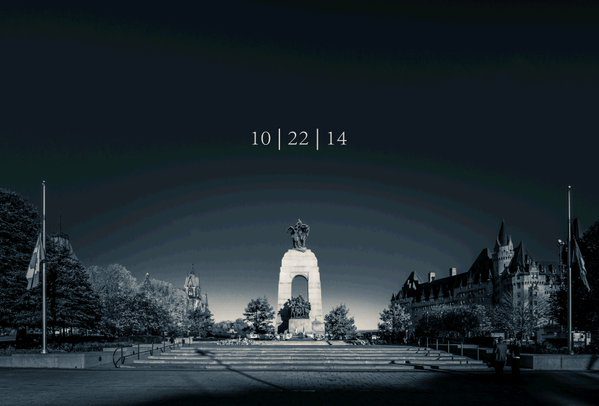On October 22, 2014, news of the Ottawa shooting began with a misspelled tweet and a cellphone video by Globe and Mail reporter Josh Wingrove. At the same time, veteran CBC cameraman Jean Brousseau quietly rolled his camera and collected raw footage that would later tell a full insider story while Bruce Arthur, sports columnist for the Toronto Star, found himself near Parliament Hill instead of the hockey arena.
Gunfire in pariament
— Josh Wingrove (@josh_wingrove) October 22, 2014
Visual discretion is advised (Source: CBC)
The structure of the reports were non-traditional: bullet points, quotes, brief summary paragraphs with links to allow for the option to dig deeper, photo galleries with informative captions and interactive maps. By forgoing the news briefs and article format, the live coverage in this way permitted more engagement and more consistent and updated information.
This is why, when looking back at the archives, one hopes that someone patted all these journalists on the back for accomplishing what they did on that day. Maclean’s had an ongoing ScribbleLive stream of tweets, photos, videos and audio. The Globe put together an interactive timeline that included time-stamped maps, tweets, updates and raw cellphone photos and videos from their reporters on Parliament Hill.
The rapid collation of information and visual illustration of all the details only continued in the days and months after the shooting. The Globe staff put together a “What we know so far” piece, assimilating the same elements as their live coverage. CBC put up the raw footage collected by Brousseau and reconstructed everything that happened on the Hill, based solely on the video. Maclean’s also reconstructed the entire day’s events solely through quotes from witnesses, politicians, security members and so forth who were at or near the site in question.

And then there was the commentary that retraced the entire day again. Ian Brown took the reader through Ottawa “in the footsteps of a killer” the day after the shooting. Arthur walked us through the streets hours after the shooting ended in an article published on the day (to me, the most memorable article from the day). A couple of months later, Wingrove took us through his first-hand traumatic experience and its psychological aftermath.
All these articles and interactive timelines are a testament to the multifaceted nature of modern-day journalism that only intensifies in live situations like the Ottawa shooting. The successful execution of the examples above are a testament to the fact that even live coverage can be detailed and extensive, and that the efforts that went—and are still going—into portraying the full story are worthy of recognition.
On it’s one year anniversary, Maclean’s put together a long-form feature detailing the actions during and after the shooting of “the heroes of October 22“, and The Globe and Mail put together another timeline of yesterday’s memorial ceremony, adding links to past multimedia articles from the day for context.
Perhaps, one year on, we should have a conversation about the lines of live reporting in this way. Josh Wingrove’s video has been viewed over 4.5 million times now, but no one ever asked if it should have been released as quickly as it was. Couldn’t it have compromised the situation? Couldn’t it have caused trauma despite the disclaimer for viewers it was released with? Would the live reporting have been as strong without it?
These questions weren’t asked because they didn’t need to be. Despite the rapidness of the day and the multi-faceted details of the shooting, Canadian news organisation gave an impressive display of thorough and careful reporting. There were no glaring mistakes made. There were no breaches caused. In fact, the combination of live-tweeting, multimedia and interactive journalism and quick, thoughtful commentary on October 22 may be one of the best displays of Canadian journalism.
About the author
Fatima Syed is the blog editor of the spring 2016 issue of the Ryerson Review of Journalism.

